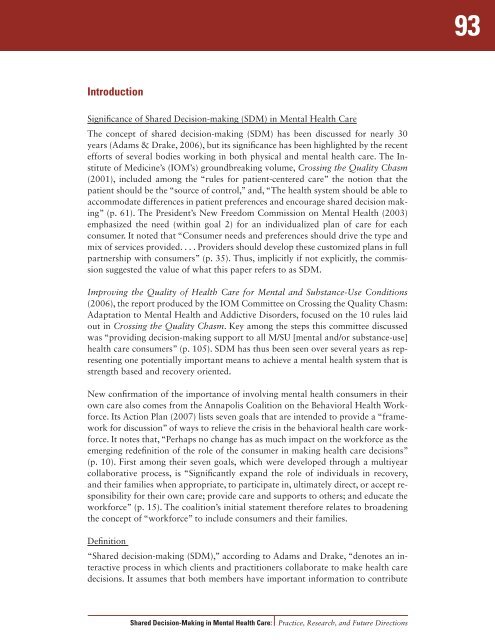Shared Decision-Making in Mental Health Care - SAMHSA Store ...
Shared Decision-Making in Mental Health Care - SAMHSA Store ...
Shared Decision-Making in Mental Health Care - SAMHSA Store ...
Create successful ePaper yourself
Turn your PDF publications into a flip-book with our unique Google optimized e-Paper software.
93IntroductionSignificance of <strong>Shared</strong> <strong>Decision</strong>-mak<strong>in</strong>g (SDM) <strong>in</strong> <strong>Mental</strong> <strong>Health</strong> <strong>Care</strong>The concept of shared decision-mak<strong>in</strong>g (SDM) has been discussed for nearly 30years (Adams & Drake, 2006), but its significance has been highlighted by the recentefforts of several bodies work<strong>in</strong>g <strong>in</strong> both physical and mental health care. The Instituteof Medic<strong>in</strong>e’s (IOM’s) groundbreak<strong>in</strong>g volume, Cross<strong>in</strong>g the Quality Chasm(2001), <strong>in</strong>cluded among the “rules for patient-centered care” the notion that thepatient should be the “source of control,” and, “The health system should be able toaccommodate differences <strong>in</strong> patient preferences and encourage shared decision mak<strong>in</strong>g”(p. 61). The President’s New Freedom Commission on <strong>Mental</strong> <strong>Health</strong> (2003)emphasized the need (with<strong>in</strong> goal 2) for an <strong>in</strong>dividualized plan of care for eachconsumer. It noted that “Consumer needs and preferences should drive the type andmix of services provided. . . . Providers should develop these customized plans <strong>in</strong> fullpartnership with consumers” (p. 35). Thus, implicitly if not explicitly, the commissionsuggested the value of what this paper refers to as SDM.Improv<strong>in</strong>g the Quality of <strong>Health</strong> <strong>Care</strong> for <strong>Mental</strong> and Substance-Use Conditions(2006), the report produced by the IOM Committee on Cross<strong>in</strong>g the Quality Chasm:Adaptation to <strong>Mental</strong> <strong>Health</strong> and Addictive Disorders, focused on the 10 rules laidout <strong>in</strong> Cross<strong>in</strong>g the Quality Chasm. Key among the steps this committee discussedwas “provid<strong>in</strong>g decision-mak<strong>in</strong>g support to all M/SU [mental and/or substance-use]health care consumers” (p. 105). SDM has thus been seen over several years as represent<strong>in</strong>gone potentially important means to achieve a mental health system that isstrength based and recovery oriented.New confirmation of the importance of <strong>in</strong>volv<strong>in</strong>g mental health consumers <strong>in</strong> theirown care also comes from the Annapolis Coalition on the Behavioral <strong>Health</strong> Workforce.Its Action Plan (2007) lists seven goals that are <strong>in</strong>tended to provide a “frameworkfor discussion” of ways to relieve the crisis <strong>in</strong> the behavioral health care workforce.It notes that, “Perhaps no change has as much impact on the workforce as theemerg<strong>in</strong>g redef<strong>in</strong>ition of the role of the consumer <strong>in</strong> mak<strong>in</strong>g health care decisions”(p. 10). First among their seven goals, which were developed through a multiyearcollaborative process, is “Significantly expand the role of <strong>in</strong>dividuals <strong>in</strong> recovery,and their families when appropriate, to participate <strong>in</strong>, ultimately direct, or accept responsibilityfor their own care; provide care and supports to others; and educate theworkforce” (p. 15). The coalition’s <strong>in</strong>itial statement therefore relates to broaden<strong>in</strong>gthe concept of “workforce” to <strong>in</strong>clude consumers and their families.Def<strong>in</strong>ition“<strong>Shared</strong> decision-mak<strong>in</strong>g (SDM),” accord<strong>in</strong>g to Adams and Drake, “denotes an <strong>in</strong>teractiveprocess <strong>in</strong> which clients and practitioners collaborate to make health caredecisions. It assumes that both members have important <strong>in</strong>formation to contribute<strong>Shared</strong> <strong>Decision</strong>-<strong>Mak<strong>in</strong>g</strong> <strong>in</strong> <strong>Mental</strong> <strong>Health</strong> <strong>Care</strong>: Practice, Research, and Future Directions
















